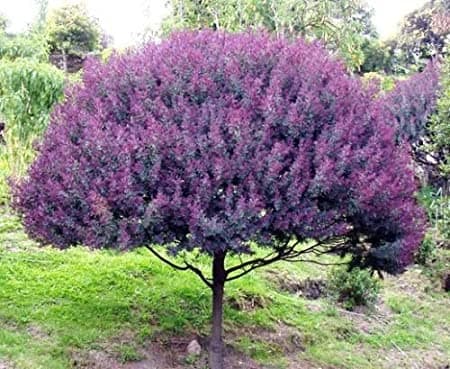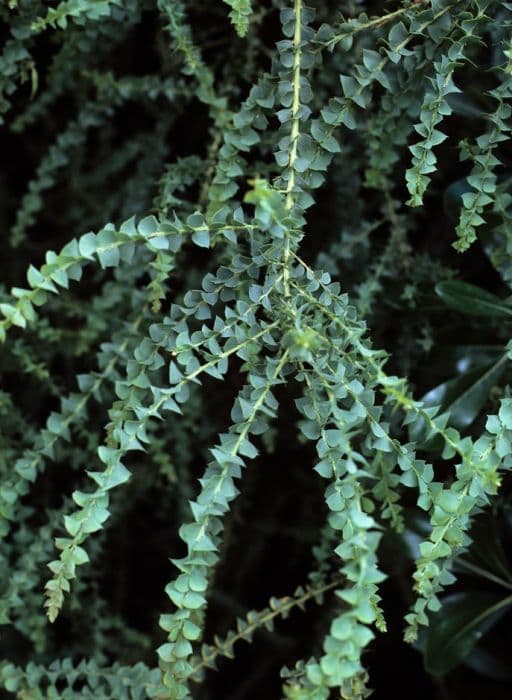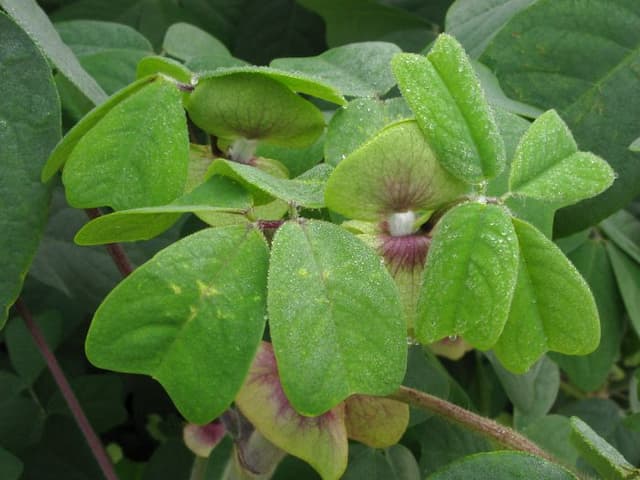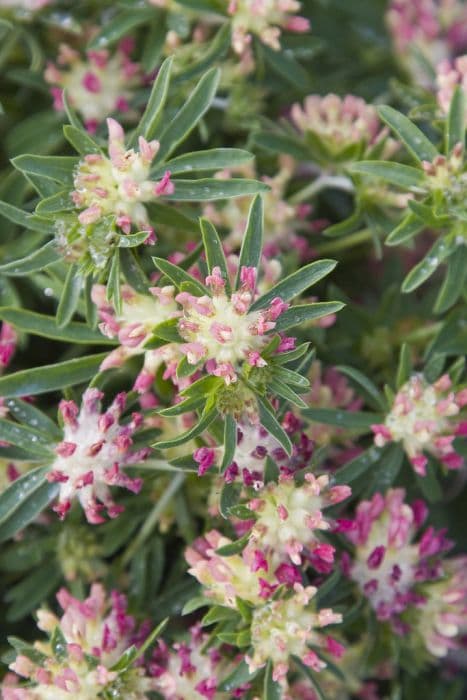Sweet pea Lathyrus odoratus 'Eclipse'

ABOUT
Lathyrus odoratus 'Eclipse' is commonly known as Sweet Pea. This plant is known for its striking blooms, which possess a distinctive and inviting fragrance. The flowers of the 'Eclipse' variety are characterized by their deep maroon petals that are almost black in appearance, contrasted with a bright, cerise-pink ripple. When the plant flowers, the blooms usually present in clusters, creating a visually impressive display that can be both eye-catching and an aromatic highlight in any garden. The foliage of the Sweet Pea 'Eclipse' consists of bright green leaves that are typically pinnate, meaning they have multiple leaflets arranged on either side of a common axis. The leaves are delicate and yet they add a lovely contrast to the dark, rich color of the blooms. The stems are slender and also green, providing support for the flowers but also contributing to the plant’s overall aesthetics by lending a sense of height and structure without detailing their measurements. As a climbing plant, Sweet Pea 'Eclipse' often requires support to reach its full potential, such as a trellis or fence to twine around. The tendrils that sprout from the stems allow it to grip onto structures and other plants, giving it a certain elegance as it interweaves and creates a wall of color and scent.
About this plant
 Names
NamesFamily
Fabaceae.
Synonyms
Sweet Pea, Everlasting Pea, Sweetpea, Lathyrus.
Common names
Lathyrus odoratus.
 Toxicity
ToxicityTo humans
Sweet pea (Lathyrus odoratus 'Eclipse') is an ornamental plant known for its fragrance and attractive flowers. While its beauty is alluring in gardens, it is important to note that all parts of the sweet pea plant, especially the seeds, can be toxic to humans if ingested. The toxic principle in sweet pea is a compound called Lathyrogens which may cause a condition called lathyrism if consumed in large quantities. Lathyrism is a neurological disease that can result in symptoms such as weakness and paralysis of the lower limbs, and in severe cases, it can lead to difficulty walking or even permanent paralysis. It is essential to avoid consuming any part of the plant to prevent these potential health issues.
To pets
Sweet pea (Lathyrus odoratus 'Eclipse') is also potentially toxic to pets. The entire plant, particularly the seeds, contains amino acid-like substances known as Lathyrogens that can cause lathyrism if ingested in significant amounts. In pets, symptoms of lathyrism may include lethargy, tremors, seizures, and in severe cases, paralysis. Pets should not be allowed to ingest any part of the sweet pea plant to avoid the risk of toxicity and the associated health complications. If you suspect your pet has ingested sweet pea, seek veterinary attention immediately.
 Characteristics
CharacteristicsLife cycle
Annuals
Foliage type
Deciduous
Color of leaves
Green
Flower color
Mixed
Height
6 feet (1.8 meters)
Spread
1 foot (0.3 meters)
Plant type
Climber
Hardiness zones
2-11
Native area
Mediterranean
Benefits
 General Benefits
General Benefits- Ornamental value: Lathyrus odoratus 'Eclipse', commonly known as sweet pea, has vibrant and colorful flowers that add aesthetic appeal to gardens and landscapes.
- Fragrance: Sweet peas are well-known for their pleasant and sweet fragrance, which can perfume an entire garden area.
- Cut flowers: They make excellent cut flowers for vases and arrangements due to their long stems and attractive blooms.
- Pollinator attraction: Sweet peas can attract bees, butterflies, and other beneficial insects, supporting local ecosystems.
- Vertical interest: Sweet peas are climbers and can be grown on trellises or supports, adding vertical interest to a garden space.
- Easy to grow: They are relatively easy to grow and suitable for a wide range of climates, making them accessible to many gardeners.
- Variety of colors: 'Eclipse' and other varieties of sweet peas come in a wide range of colors, allowing for personalized color schemes in garden design.
- Seasonal beauty: They bloom in the spring and summer, providing seasonal beauty and visual interest in the garden during these times.
- Edible history: While not all sweet peas are edible, they belong to the family Fabaceae, which includes many edible legumes, and have a history of cultivation for various uses.
- Genetic diversity: Cultivars like 'Eclipse' contribute to the genetic diversity of garden plants, allowing for continuous improvement and selection of desirable traits.
 Medical Properties
Medical PropertiesThis plant is not used for medical purposes.
 Air-purifying Qualities
Air-purifying QualitiesThis plant is not specifically known for air purifying qualities.
 Other Uses
Other Uses- Artistic Inspiration: Sweet pea 'Eclipse' varieties, with their striking colors and patterns, have inspired painters and illustrators for floral art and designs.
- Dye Production: The petals of the Sweet pea have historically been used to create natural dyes for fabric, although not commonly known for this purpose.
- Culinary Garnishes: While not widely recognized for edibility, Sweet pea flowers may be used as decorative, non-toxic garnishes for food plating, adding a splash of color to dishes.
- Perfumery: Although not directly used as an ingredient, the strong fragrance of Sweet peas serves as an inspiration for creating perfumes with similar scent profiles.
- Education and Research: Sweet peas are sometimes used in genetic studies and educational settings for illustrating Mendelian inheritance, due to their variety of flower colors.
- Eco-printing: The flowers and leaves of Sweet peas can be used in eco-printing, a sustainable art form that transfers natural pigments to paper or fabric.
- Craft Projects: The dried seed pods of Sweet pea plants can be used in crafting projects, often painted or coated with varnish for decoration.
- Wedding Decor: Sweet peas are a popular choice for wedding bouquets and venue decoration due to their delicate appearance and enchanting fragrance.
- Photography Subjects: The vibrant Sweet pea 'Eclipse' can be an exquisite subject for macro photography, capturing the intricate beauty of its blooms.
- Literature and Poetry: The Sweet pea's charm has made it a recurrent theme in poetry and literature, symbolizing delicate pleasure and blissful pleasure.
Interesting Facts
 Feng Shui
Feng ShuiSweet Pea is not used in Feng Shui practice.
 Zodiac Sign Compitability
Zodiac Sign CompitabilitySweet Pea is not used in astrology practice.
 Plant Symbolism
Plant Symbolism- Blissful Pleasure: Sweet pea, the common name of Lathyrus odoratus 'Eclipse', traditionally symbolizes pleasure. The captivating scent and delicate blossoms invite feelings of enjoyment and delight.
- Goodbye or Departure: Sweet peas can also indicate farewell, as their presence has historically been associated with wishing someone a fond goodbye and good luck in their endeavors.
- Thank You for a Lovely Time: Often given after enjoying time spent with someone, sweet peas express appreciation and gratitude for the pleasure of someone's company.
- Lasting Pleasure: With their prolonged blooming season and enduring fragrance, sweet peas signify pleasures that last, making them a symbol of lasting enjoyment and happiness.
- Delicate or Blissful Pleasure: The sweet pea's fragility is a reminder of the fine and delicate moments in life, encouraging an appreciation of brief, yet beautiful experiences.
 Water
WaterSweet peas, including the variety Lathyrus odoratus 'Eclipse', should be watered deeply once a week, providing about 1 inch of water which amounts to roughly 0.6 gallons per square foot. It's important to avoid overhead watering to prevent disease, so water at the base of the plants. During hot spells or in particularly dry climates, increase watering to twice per week. Ensure the soil is well-drained as sweet peas dislike waterlogged soil. Consistently moist soil is important, especially when the plants are blooming.
 Light
LightSweet peas like Lathyrus odoratus 'Eclipse' thrive in full sun, which means they should receive at least 6 to 8 hours of direct sunlight daily. An ideal spot would be in an area that is sunny with some protection from the hottest part of the day. Avoid planting in full shade as this will reduce flowering and can lead to weaker growth.
 Temperature
TemperatureSweet peas, such as Lathyrus odoratus 'Eclipse', prefer cooler climates and perform best in temperatures between 55°F and 65°F. They can handle short periods of frost but prolonged exposure to temperatures below 20°F could be damaging. Conversely, sweet peas often start to decline if temperatures consistently exceed 80°F. They grow optimally in spring and fall when temperatures are mild.
 Pruning
PruningRegularly deadheading sweet peas, including the variety Lathyrus odoratus 'Eclipse', encourages continuous blooming. Snip off spent flowers and seed pods every few days to maintain productivity. Additionally, light pruning of the tips when plants are 4 to 6 inches tall can encourage bushier growth. The best time to prune is throughout the blooming season to promote more flowers.
 Cleaning
CleaningAs needed
 Soil
SoilSweet peas, including 'Eclipse', thrive in well-drained soil, rich in organic matter, with a pH between 6.0 and 7.5. A mix of two parts loam, one part peat moss or well-rotted compost, and one part sharp sand or perlite makes an ideal soil composition for this plant. Additionally, incorporating a slow-release fertilizer will help support their vigorous growth.
 Repotting
RepottingSweet pea 'Eclipse' does not typically require repotting as they are annuals; these plants complete their life cycle in one season. In general, repotting is not applicable, but young plants may be transplanted from seedling containers to their final outdoor positions in the garden once the risk of frost has passed.
 Humidity & Misting
Humidity & MistingSweet peas, such as 'Eclipse', prefer moderate ambient humidity levels. These plants are adaptable to outdoor conditions and do not require specific humidity control, but they will benefit from being grown in areas where the air is not too dry to prevent stress on the plants.
 Suitable locations
Suitable locationsIndoor
Place in bright, indirect light and cool temps.
Outdoor
Plant in sunny spot, sheltered, after last frost.
Hardiness zone
2-11 USDA
 Life cycle
Life cycleSweet pea 'Eclipse' begins its life as a seed, typically sown in late winter or early spring. Germination occurs when soil temperatures reach around 55-65°F, leading to the emergence of seedlings with primary leaves. As the plant develops, it produces a climbing stem that requires support and produces compound leaves with tendrils that grasp structures for climbing. Flowering occurs in late spring or early summer, displaying the characteristic fragrant blossoms that range in color, depending on the variety. After pollination, typically by bees, the plant develops seed pods containing seeds that mature by late summer. The plant completes its life cycle when it drops seeds to the ground or they are harvested for propagation, and the annual plant typically dies after seed production.
 Propogation
PropogationPropogation time
Spring to early summer
For the sweet pea variety known as Lathyrus odoratus 'Eclipse', the most popular method of propagation is by sowing seeds directly into the ground. The ideal time to sow sweet pea seeds is in late winter or early spring when the soil can be worked and is not frozen, as long as temperatures are not expected to drop below 45 degrees Fahrenheit (7 degrees Celsius). To encourage quicker germination, it's often recommended to soak the seeds in water for 24 hours prior to planting. Seeds should be sown about 1 inch (2.5 cm) deep and spaced around 2 to 3 inches (5 to 7.5 cm) apart in a well-draining soil rich in organic matter. Once sown, the seeds typically germinate within 10 to 21 days, depending on the soil temperature and conditions. Sweet peas prefer a sunny location with support for climbing, as they are a vining plant. Regular watering and occasional feeding will help to establish strong plants that can produce flowers throughout the growing season.









